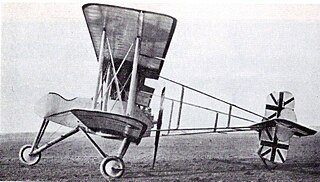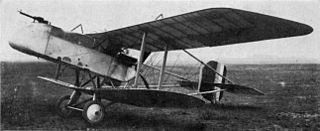Related Research Articles

The AD Flying Boat was designed by the British Admiralty's Air Department to serve as a patrol aircraft that could operate in conjunction with Royal Navy warships. Intended for use during the First World War, production of the aircraft was terminated as the end of the war came into sight, and the type saw little operational use. A number were repurchased after the end of the war by Supermarine Aviation and rebuilt as civil transports, becoming known as the Supermarine Channel.
The AD Navyplane was designed by the British Admiralty's Air Department as a reconnaissance aircraft for use during World War I. Performance of the prototype was so disappointing that plans to produce it were cancelled almost immediately.

The Airco DH.2 was a single-seat biplane "pusher" aircraft which operated as a fighter during the First World War. It was the second pusher design by aeronautical engineer Geoffrey de Havilland for Airco, based on his earlier DH.1 two-seater.

Between 1911 and 1914, the Royal Aircraft Factory used the F.E.2 designation for three quite different aircraft that shared only a common "Farman" pusher biplane layout.

The Vickers F.B.5 was a British two-seat pusher military biplane of the First World War. Armed with a single .303 in (7.7 mm) Lewis gun operated by the observer in the front of the nacelle, it was the first aircraft purpose-built for air-to-air combat to see service, making it the world's first operational fighter aircraft.

The Royal Aircraft Factory F.E.1 was designed and built in 1910 by the pioneer designer Geoffrey de Havilland. He used it to teach himself to fly during late 1910. After De Havilland was appointed assistant designer and test pilot at the Army Balloon Factory at Farnborough in December 1910 the War Office bought the aircraft for £400. the aircraft was given the designation F.E.1

The Royal Aircraft Factory F.E.8 was a British single-seat fighter of the First World War designed at the Royal Aircraft Factory. Although a clean and well designed little aeroplane for a pusher, it could not escape the drag penalty imposed by its tail structure and was no match for the Albatros fighters of late 1916.

This article is about an aircraft of World War I. For the pre-war design of the same designation, see Breguet Type IV.
The Supermarine Baby was a British flying boat fighter aircraft of the First World War designed and built by the Supermarine Aviation Works. Although only one was built, it formed the basis for the later Sea King fighter and Sea Lion I racer.

The Vickers F.B.26 Vampire was a British single-seat pusher biplane fighter built by Vickers during the First World War.
The Austin Greyhound was a British two-seat biplane fighter aircraft of World War I built by car manufacturer Austin. Owing to the end of the War and an unreliable engine, it was unsuccessful, only three being built.

The Vickers F.B.12 was a biplane pusher fighter aircraft developed during World War I by Vickers Limited. The failure of the engine for which it was designed, and the obsolescence of the pusher configuration, resulted in its remaining an experimental type only.
The Grahame-White Ganymede was a prototype British heavy night bomber intended to serve with the Royal Air Force in the First World War. A large, three-engined, twin-boom biplane, the sole prototype Ganymede did not fly until after the war had ended, and although an attempt was made to convert the aircraft to an airliner, it was unsuccessful.
The Sopwith Gunbus was a British fighter aircraft of the First World War. It was a single-engined pusher biplane based on a floatplane built by Sopwith before the war for Greece. Small numbers were built and used by the British Royal Naval Air Service, mainly as a trainer.

The Royal Aircraft Factory F.E.9 was a prototype British two-seat fighter-reconnaissance aircraft of the First World War. A single-engined pusher biplane of 1917, the F.E.9 had poor performance and handling, and only three were built.

The Royal Aircraft Factory N.E.1 was a prototype British Night fighter of the First World War. A single-engined pusher biplane, it was a development of the Royal Aircraft Factory's earlier F.E.9 fighter, but was not successful, only six being built.

The Curtiss C-1 Canada was a twin-engined bomber aircraft of the First World War which was designed by Curtiss of America to be built by their Canadian subsidiary for the British Royal Naval Air Service and Royal Flying Corps. Although large orders were placed, only twelve were built, the type being rejected in favour of more capable aircraft such as the Handley Page O/100.
The Royal Aircraft Factory C.E.1 was a prototype British flying boat of the First World War. It was a single-engined pusher configuration biplane intended to carry out coastal patrols to protect shipping against German U-boats, but only two were built, the only flying boats to be designed and built by the Royal Aircraft Factory.

The Vickers F.B.25 was a British two-seat night fighter prototype of World War I designed to attack enemy airships. Completed in 1917, it failed in its official flight tests that year and no order for production resulted.
The Vickers E.F.B.1 'Destroyer' was an early British military aircraft prototype. Although not itself a success, the design was considered worth developing, and a series of similar aircraft were produced in prototype form, eventually leading to the Vickers F.B.5 "Gunbus", which saw widespread service during World War I.
References
- Bruce, J. M. British Aeroplanes 1914-18. London: Putnam, 1957.
- Bruce, J. M. War Planes of the First World War: Volume Two Fighters. London: Macdonald, 1968. ISBN 0-356-01473-8.
- Bruce, J. M. "The First British Armoured Brigade", Part 2. Air International , March 1979, Vol 16 No. 3. Bromley, UK: Fine Scroll Publishing. pp. 149–153.
- Mason, Francis K. The British Fighter since 1912. Annapolis, Maryland, USA: Naval Institute Press, 1992. ISBN 1-55750-082-7.